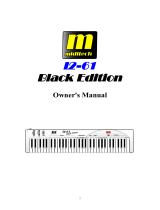
Oxygen Keyboard Line User Guide
21
English
RPN/NRPNs
Non-registered parameter numbers (NRPNs) are device-specific messages that enable the control of synths via MIDI. The MIDI
specification defines parameter numbers to allow manufacturers to specify their own controllers. The more common of these have
been registered by the MIDI Manufacturer's Association and are part of the MIDI specification (hence the term Registered Parameter
Numbers – RPNs). (See Appendix F for additional information.)
MIDI controllers 98 and 99 represent the NRPN LSB and MSB respectively, while 100 and 101 represent the RPN LSB and MSB. This can
be seen in the MIDI controllers list in Appendix E. To transmit an NRPN/RPN, these two controller messages are sent along with their
user-specified values. An additional controller message and value needs to be sent to specify the (coarse or fine) value adjustment.
This is specified by controller number 6 (Data Entry) for coarse adjustments or number 38 for fine adjustments.
Devices that receive NRPN messages will list NRPNs in the User Manual. It is essential to send the NRPN MSB and LSB messages
together. Both will be specified in the device's manual, but typically only in Hexadecimal format. If this is the case, you may refer to
Appendix C for help translating the value to decimal.
SysEx
System Exclusive (SysEx) messages were defined in the MIDI specification to allow control of individual devices via MIDI. The format
of SysEx messages allows virtually any function to be performed via MIDI if the receiving device can read and translate the message.
This allows devices to send audio sample memory data, memory dumps, controller settings, and much more. It also allows the
controllers of one device to be controlled by another.
It is not possible to program your own specified SysEx message into the Oxygen controller. However, several useful SysEx messages are
pre-programmed into the keyboard. They can be accessed by assigning the appropriate MIDI CC to a controller (see Appendix A).
A SysEx message is not transmitted on any specified channel. All SysEx messages contain a Device ID, which is used to single out
devices to respond to the SysEx message. All other devices are ignored. If you are using a SysEx message on the Oxygen, the Global
Channel is ignored. When you press the Channel Assign key, you will enter a Device ID instead. This is indicated by the fact that the
LED displays a 3-digit number, not a 2-digit number proceeded by a “c.”
Device IDs run from 00 to 127. 127 is the default device number setting on the Oxygen controller. This setting transmits the SysEx
message to all devices.
It is not possible to program the controllers of the Oxygen with your own SysEx messages, there are software applications that can
receive a MIDI input signal and transmit a different, user-specified message. You can program your SysEx messages into the translator
software, and then translate the incoming data from the keyboard to your SysEx, depending on the controller you are using.
12 › Troubleshooting
My M-Audio keyboard suddenly stopped working after having performed fine since installation.
• Switch off the unit and leave it alone for 10 seconds. Restart your computer and try again. If the problem persists, you may
have to re-install drivers for the unit.
My drivers are listed in the Device Manager and are said to be working, but the keyboard is not recognized in any software.
• Win2000 and XP have a limitation to how many MIDI device drivers you can have installed at any one time. However, the
operating system will not give you any indication that you are using the maximum number of drivers—the drivers will install
as if there is not a problem.
• To fix this problem, go to http://www.m-audio.com and locate the above question. You will find a link to an .exe file that will
solve this problem for you.
I have plugged in a sustain pedal to my M-Audio keyboard, but it works the wrong way.
• The polarity of the sustain pedal is calculated by the keyboard when it is powered up. On power up, the sustain pedal is
assumed to be in the OFF position. So, if you want the sustain pedal to be off when it is un-pressed, make sure the pedal is
un-pressed when you power up.
When I press a key, there is a delay before I hear any sound.
• This delay is known as latency. Latency with MIDI signals is due to the softsynth you are using. MIDI data is simply control data.
The MIDI is read by the softsynth. The softsynth then completes a large number of complex calculations, in order to produce
the sound you hear. All this takes time. If you already have an adequate sound card, try re-installing the latest drivers for the
sound card, or try reducing the buffer sizes of the audio drivers.
• If you feel that you may need a new or upgraded sound card please visit www.m-audio.com.




















